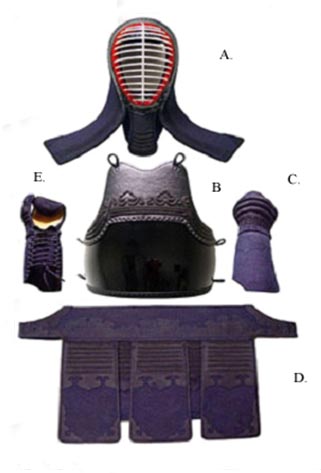

Protective equipment used in Kumdo is called Hogu(호구) and consists of 6 elements.
NOT SHOWN.) Myŏn-soo-goon (면수건,): cotton scarf worn under the helmet to absorb perspiration and prevent interference in the competitors' vision. It can also be called a "Dougong" but not to be mixed up with the Chinese definition.
A.) Homyeoum (호면): Helmet including a wire grill to protect the face.
B.) Kap (갑,): Chest protector
D.) Kapsang (갑상): Canvas and leather skirt worn around the waist to protect the hip and groin area
C,E.) Howan (호완):(pair) formed mitts with cuffs used to protect the hand and wrist area.
As with any modern contact sport, the use of a mouthguard (K.'eep bohodae') is strongly encouraged.
In addition the individual will use a bamboo sword or Juk-To with which to strike or thrust at his opponent while fending off attacks.
SWORD TERMINOLOGY
_parts.jpg)
1.) Pommel: Though identified as a part of the sword it is not accepted as a point of contact in regulation play.
2.) Ko-dûng-i: (코등이) w/ rubber retaining washer: the hilt or guard of the sword is intended to offer some protection to the hands, but is more commonly used as a point of contact in close-quarters contest.
3.) Kalnal: (칼날) --- blade of the sword is only suggested as that side of the Juk-To opposite the Duengjul (lit. "back cord")and the two-thirds portion of the Juk-To forward of the guard.
4.) Duengjul: A yellow string that stretches form the guard to the tip of the sword and signifies the spine of the sword.
5.) Joonghyuk: is the leather band marking the proximal limit of the recognized striking area of the sword.
6.) Sunnhyuk: is the leather cap representing the tip of the sword. Use of thrusts in competition is infrequent but are recognized when contact is made solely with this part of the sword.
A.) Byounghyuk: Represents the handle of the sword
B.)
C.) Ta-dol-bu: The area between the sunnhyuk and the joonghyuk representing the first third of the sword blade. In competition, a strike is counted only when the point of contact is solely with this area of the sword.
A standard Juk-To is a 120 cm (47 Inches) for all adults, with the male item weighing 500g and the female item weighing 420g. Traditionally made of 4 bamboo strips and bound with leather, advances in technology have produced items made of high-impact plastics and carbon fibers. Proportionately smaller items are available for child competitors.[4]
Lastly a Kumdo practitioner will use a Mok Geom (lit. wooden sword). Though used historically for competition, the potential for injury including the likelihood of death has caused this item to be relegated to highly structured individual and paired form-work as a substitute for using steel swords.
Kumdo practitioners wear a Dobok (도복, 道服; lit: "clothing for the way") or uniform which closely resembles that worn by Kendo practitioners, usually indigo-blue in color. Many Kumdo practitioners wear Paji ( 바지; lit. training pants ) with billowy pants legs after the fashion of Japanese hakama without koshiita though the ankles are not secured after the fashion of the Korean Hanbok or traditional dress. A heavy cotton double-weave jacket (K.Otdori; 옷도리) is worn and traditionally closed with a tie (K. Maettiôp); (매띠업) though linen ties, after the fashion of Japanese traditions, are giving way to velcro fastenings. A belt (K.Dhee; 띠), usually signifying the individuals rank or standing completes the uniform. In national tournaments, the Korean national team typically wears white Keikogi with black trim and stripes on their hakama, in contrast to the all indigo-blue worn by Kendo practitioners.
By comparison, required dress at training in the classroom may be less formal and idiosyncratic to the values of a given school or teacher. In this way, the more common Martial Arts uniform of, white and/or black pants and jacket, bound with a belt is common. Most recently there has been a growing trend towards recognizing the Korean nature of this art by binding the uniform pants legs at the ankle after the fashion of the Korean Hanbok. Though formerly accomplished with laces, velcro fastening are now used.